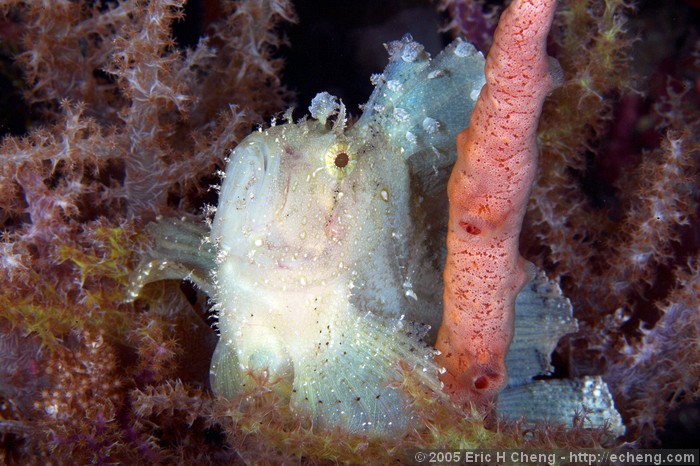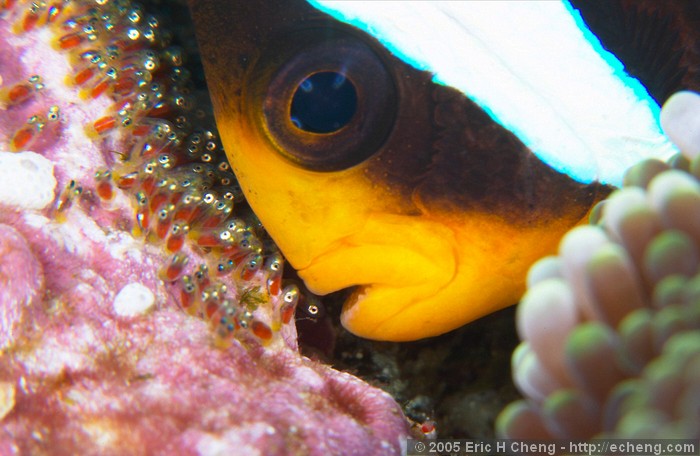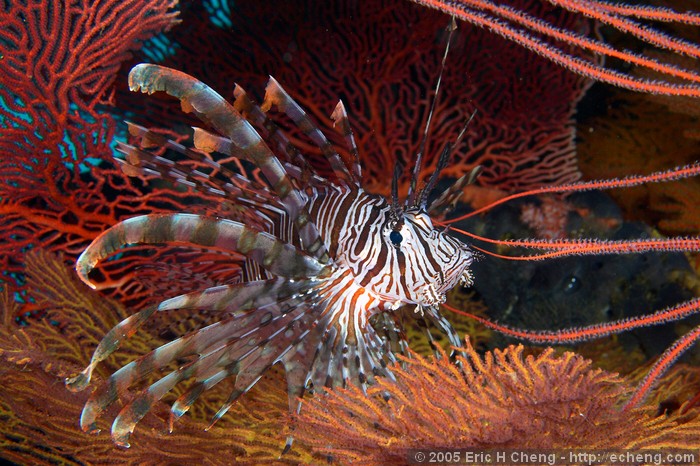




 |
 |
 |
 |
 |
We are trying to develop a community where photographers can come and discuss nature, wildlife and pet photography related matters. We encourage you to enter the forums to discuss this interview as well as to share your photographs and experiences in the other forums here at NWP.
This article is Copyright 2005, James Morrissey, and may not, in part or in whole, be reproduced in any electronic or printed medium without prior permission from the author. The images in this article are the property of Eric Cheng and have been licensed to James Morrissey and the NWP Photo Forum for the purpose of this interview.
Part III: UnderWater Photograhy Basics
 |
(c) Eric Cheng
JM: What certifications do you need to go underwater to begin with?
EC: At many resorts around the world, just about anyone can go underwater in what is commonly referred to as a "discovery dive," which is a one-time dive that consists of an instructor strapping a lot of weight on someone and throwing her into the ocean. But if one wants to get underwater regularly, there are quite a few acronymed organizations that offer classes for "proper" SCUBA certification. Typically, classes include instruction on the basics of dive-related equipment, physics, and safety, and take anywhere from a few days to several weeks to complete. Getting certified as a diver prepares you to SCUBA dive safely and legally.
JM: What equipment do you need?
EC: At the minimum, one needs a well-fitting mask, snorkel, and fins. In cold-water locations, most dive shops also require personal neoprene gloves and booties. The rest -- wetsuit/drysuit, buoyancy compensating device (BCD), regulator, dive computer, tank, and weights -- can be rented. However, all serious divers dive with their own equipment (everything but tank and weights); my gear is what keeps me alive and maneuverable underwater, and being familiar with it is very important.
JM: How much money do you think it takes to START to do this?
EC: Basic SCUBA certification costs anywhere from US $200-300, plus "personal" gear (mask, snorkel, fins, booties, and gloves), which will set you back at least $200. If you only own personal gear, you'll have to rent equipment each time you dive, which can get expensive if you do a lot of diving.
JM: What photographic gear are you using? What lenses and other gear do you prefer to use?
EC: I use a Canon 1Ds Mk II in a Seacam housing, with Ikelite DS-125 and INON Z-220 strobes. The lenses that I favor underwater are the Canon 15mm/2.8 full-frame fisheye, Tokina 17mm, Sigma 20mm/1.8, Canon 24mm/1.4L, Canon 35mm/1.4L, Sigma 50mm macro, Canon 100mm USM macro, and Canon 180mm USM macro. I use a Canon 1D Mk II as a backup, or as a topside camera when the other one is in the housing.
I picked the Seacam housing because it is the highest-quality housing on the market. At the time, it was also the *only* housing for the 1D series camera. :) I like to use equipment that just works. I don't need to admire the gear, nor stroke it because it is so beautiful. I'd rather have gear that I don't need to think about -- gear that just works.
 |
(c) Eric Cheng
JM: Why did you pick the light system you did?
EC: I use Ikelite DS-125 strobes and INON Z-220 strobes. The Ikelites produce a very pleasing image and have a nice, circular beam. The INONs are smaller, and built like small, uh... plastic tanks. :) I use Fisheye modeling lights at night.
JM: What is it like going underwater with your camera system and housing?
EC: Underwater, my housed camera and lighting system is like a part of me; I have probably only spent one or two of the last several hundred dives without my camera. Actually, I can't remember the last time I dove without it!
Maneuvering underwater with a large camera can be very difficult in extreme current. Anyone who has tried to drag a large object through the water knows that it takes a considerable amount of effort to do so. I use a lot more air when I have my camera with me, and it took me some time before I became relaxed enough to breathe normally.
Sometimes, having a large camera underwater is comforting. Specifically, I like having the large chunk of metal around when I am in the water with curious sharks. :)
Inexperienced divers usually find going underwater with a photography rig to be very challenging, and I often see divers with cameras trashing the reef (without noticing their actions, I mean). For the sake of the underwater environment, I recommend relative mastery of SCUBA diving skills before attempting to take a camera underwater.
 |
(c) Eric Cheng
JM: What does this all do with your camera insurance?
EC: We underwater photographers use specialized insurance for our gear, which covers theft, flood, and damage in harsh environments. Specifically, most of us use DAN's H2O Insurance (http://www.h2oinsurance.com/) or D.E.P.P. (http://www.equipmentprotection.com/programs/depp.html). Some people try to add riders to home-owners or renters insurance, but I've heard horror stories about being dropped from policies after making claims. Personally, I'd rather not gamble with my home-owners insurance.
JM: Can you tell us more about the physical experience of going underwater?
EC: A lot of my friends tell me that they're afraid to go underwater because they are claustrophobic -- which has always confused me. The experience of being underwater in clear water evokes quite the opposite of claustrophobia. Rather, it is the complete freedom of motion in three dimensions! Drifting along in strong currents is probably as close to flying as one can get, and using one's lungs to ascent and descend adds a dimension to maneuverability that I've learned to really enjoy.
The real reason we all go underwater is to be exposed to the amazing wildlife. Nature goes completely crazy underwater, and animals look bizarre and are commensal in ways that we land creatures could never have imagined.
JM: What marine environments do you prefer to work in?
EC: Well, I prefer warm, crystal-clear water, but that isn't always available where there is interesting wildlife. :)
JM: Where are your favorite places to photograph? (It had better not be someplace landlocked - smile :)
EC: I don't really have favorite places to photograph, but I've spent a lot of time diving time in the Bahamas, Galapagos, and South Pacific -- all of which I love. I love the Bahamas for its incredible large shark action, the Galapagos for its whale sharks, hammerheads, and amazing and bizarre topside wildlife, and the South Pacific for its incredible diversity in marine life. I also really like French Polynesia for its water clarity and amazing schools of gray reef sharks.
If you would like to see more of Eric's work, please feel free to check out his websites at: http://www.wetpixel.com and http://www.echeng.com.
As always, we encourage you to come join the community and to be participants in the forums!
 |
 |
 |
 |